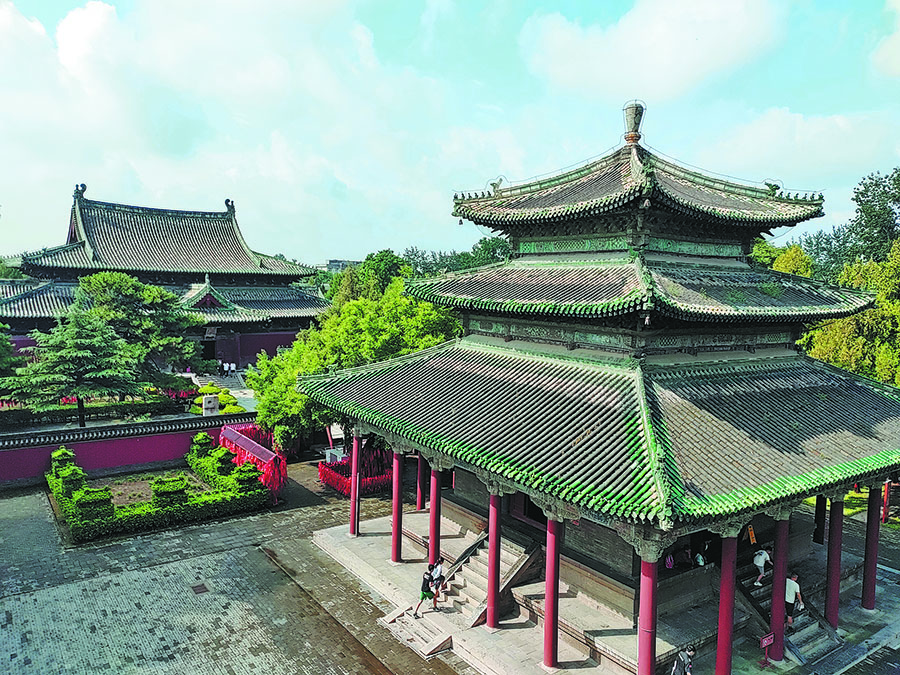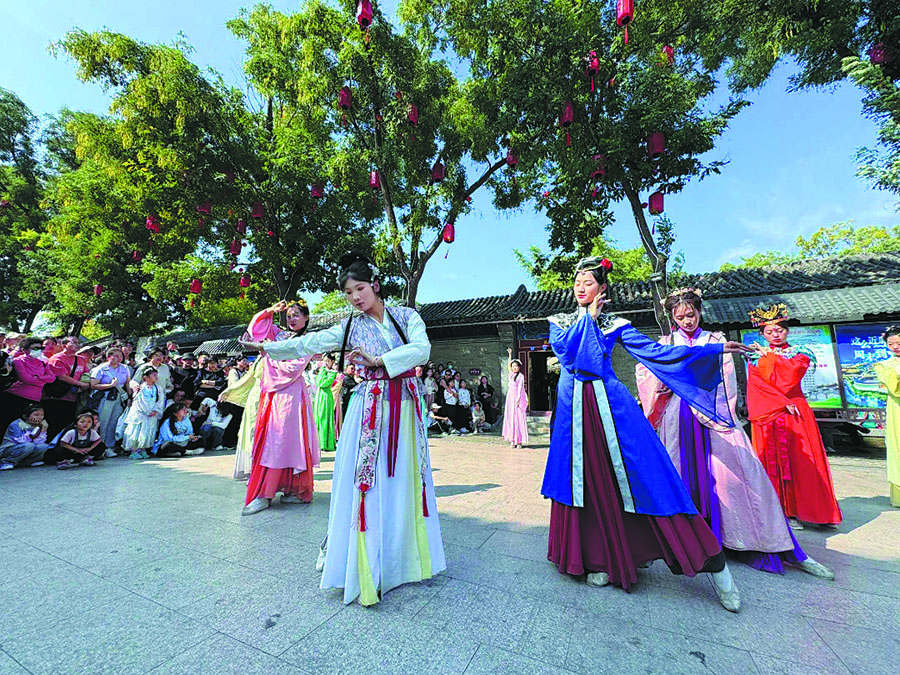
Longxing Temple, first built during the Sui Dynasty(581-618). [PHOTO BY WANG KAIHAO/CHINA DAILY]Greater number of tourists are discovering the charms and architecture of ancient Zhengding, reports Zhang Yu in Shijiazhuang.
One day as the sun was setting in April 1933, Liang Sicheng(1901-72), the architect, architectural historian and educator, also known as the"father of modern Chinese architecture", arrived at Zhengding Railway Station by train from Beijing. The journey was the beginning of his exploration of the ancient county of Zhengding in Shijiazhuang, Hebei province.
"I was struck by the grandeur of Zhengding within minutes of arriving, which came as a surprise to me. However, at the time, I was unaware that amid the densely packed houses there were many treasures waiting to be discovered, "Liang was quoted as saying in Pindu Zhengding("savoring Zhengding"), a book by Sun Wanyong, a former Party secretary of the county.
Located about 250 kilometers southwest of central Beijing, the ancient county that took Liang 10 hours to reach in the 1930s sits beside the Hutuo River in the northern part of Shijiazhuang city.
With a long and impressive history, Zhengding was designated a national historical and cultural city by the State Council in 1994.
Setting it apart from many other ancient downs and cities in China, Zhengding is remarkable in that many of its ancient buildings have survived war and natural disasters.
Within the small historical county, which covers less than 10 square kilometers, there are dozens of ancient structures, including 10 national-level key cultural heritage protection units, five provincial-level cultural protection units, and more than 7, 600 cultural artifacts in the local museum collection. Today, 38 ancient buildings still exist in the county seat.
Zhengding was mainly known for its"nine towers, four pagodas, and eight major temples, along with 24 ornamental archways", evidence of its abundance of famous historical sites dating back to as early as the Sui Dynasty(581-618).
The"four pagodas"refers to the four ancient pagodas in four temples, while the"eight major temples"were those built during Zhengding's prosperous historical periods, as early as the Sui and Tang(618-907)dynasties, and were renovated throughout history. Five are still well-preserved.

Zhengding county of Shijiazhuang, Hebei province, boasts many examples of ancient architecture, including top corner of the Kaiyuan Temple of the Tang Dynasty(618-907). [PHOTO BY WANG KAIHAO/CHINA DAILY]Graceful presence
Among them, Liang referred to Longxing Temple as one of the most well-known temples outside Beijing. Built in 586, it is one of the earliest and largest well-preserved Buddhist temples in China, and it left a deep impression on him.
In his later research on ancient architecture, he repeatedly referred to Longxing as"brilliant", "magnificent"and"profound", according to Sun.
"It has the only surviving revolving Buddhist scripture bookcase from the 10th century in China. The structure of the bookcase pavilion is particularly exquisite, a masterpiece of wooden architecture. …It made us ecstatic, and happily thrilled, "Liang was quoted as saying, upon seeing the Zhuanlunzang Ge, or revolving bookcase pavilion, at Longxing Temple. The quote is recorded in Sun's book.
Liang was also surprised by the temple's other treasures, including the Moni Dian, or Hall of Manichaean, from the Northern Song Dynasty(960-1127)period, in which there's another treasure—a multicolored statue of Avalokitesvara(Guanyin).

A statue of Avalokitesvara(Guanyin)in Longxing Temple. [Photo provided to China Daily]The statue, in a sitting posture, wears a crown, draped in ornaments. One foot rests on a lotus, while the other rests on the thigh. Both hands are placed naturally on the knee, exuding a sense of tranquillity. The statue breaks with the stiffness often associated with religious images, and embodies a more natural and graceful presence.
The Lingxiao pagoda, a brick-and-wood hybrid tower in neighboring Tianning Temple that is built in the form of an octagonal pavilion-style structure and is 40. 98 meters high, and the Xumi(or Sumeru)pagoda, built in 636 of the Tang Dynasty at the Kaiyuan Temple, also caught Liang's eye.
After this initial journey, Liang found himself drawn repeatedly to Zhengding by these treasures and visited many buildings again on several occasions, measuring, photographing and even discovering new buildings, according to records.
He also made detailed architectural drawings of eight structures, including the Moni Dian, and the Zhuanlunzang Ge.

Zhengding county of Shijiazhuang, Hebei province, boasts many examples of ancient architecture, including the eave of a main hall of the Confucius Temple built in the Five Dynasties and Ten Kingdoms(907-960). [PHOTO BY WANG KAIHAO/CHINA DAILY]Stunning vista
Liang's research led to Zhengding's ancient architecture becoming known as exemplary models, and they served as teaching materials for students majoring in architecture.
"If all of this reflects Liang's love for Zhengding's ancient buildings, then the meticulous restoration and protection of these ancient buildings embodies his earnest hopes and expectations, "Sun says.
The county has not let Liang down. Since the 1980s, its ancient buildings have been protected, and buildings like the Moni Dian in Longxing Temple and the Xumi pagoda have been restored.
Fast-forward to 2024, and this small county has transformed itself into one of the most famous tourist attractions in North China, attracting visitors from all around the country, and even from overseas.
What draws them is the county's cultural heritage.
Walk along Yanzhao South Street, a major historical and cultural street in Zhengding lined with temples on both sides, which leads to the Nanchengmen("south gate")area, and you'll see tourists dressed in hanfu(traditional Chinese clothing), strolling along the street, joking, and posing for photos against the backdrop of red brick walls.
At night, the Nanchengmen area becomes one of the liveliest spots in Zhengding. During holidays, crowds of people walk onto the city gate to enjoy beautiful night views.
Looking from south to north reveals a stunning vista of the county, with the most eye-catching elements being the illuminated ancient pagodas.
"I have never felt more proud that my hometown could become so popular, with more and more outsiders coming to appreciate its culture, including ancient sites, and also our specialty foods, "says Wang Yafeng, a 40-year-old resident of Muzhuang village.
When he was young, Wang often came to the downtown area with his mother to pray in the temples, at a time when there were not many tourists.
"However nowadays, especially during holidays like Spring Festival at the start of the Chinese Lunar Year or the National Day holiday at the start of October, Zhengding becomes very lively. Everywhere you can see bustling crowds, either visiting attractions, admiring ancient architecture, or enjoying delicious food in restaurants, "Wang says.

Performers dance at the Rong Mansion. [PHOTO BY WANG KAIHAO/CHINA DAILY]Charging stations
Zhengding county received an average of 500, 000 tourists a day during the National Day holiday this month, nearly three times more than the same period last year, according to a report by the China Media Group.
With more and more tourists coming to Zhengding, the local government has rolled out measures in recent years to improve public services.
These include 44, 800 free parking spaces, clean and tidy public toilets, free sightseeing buses, convenient charging stations for electronic vehicles, and free drinking fountains.
For Li Nan, a 36-year-old tourist from Beijing, Zhengding was the best weekend choice for her family on Oct 12 and 13. Unlike Liang, who took 10 hours to get to Zhengding in the 1930s, Li's train journey took just over an hour.
"The first day, we traveled to the county by high-speed train, and then visited many scenic spots, such as the Longxing Temple, and Rong Mansion, "Li says, talking about the trip she and her family of four took. "We also tasted many types of traditional local cuisine, like Badawan("eight big bowls"of steamed dishes). At night, we enjoyed the view and ate snacks at the famous Zhengding night market. "
Her itinerary is typical of a one-day tour of Zhengding. Rong Mansion, or Rongguo Fu is a group of buildings built in the 1980s in the style of the Ming and Qing dynasties(1368-1911), and is based on the classical novel Dream of the Red Chamber by Qingera writer Cao Xueqin.
"The food was delicious, while the ancient buildings were magnificent, but you can only get to know them better if you go with a guide, who can tell you details and stories about the old buildings, "she says.
On their second day in Zhengding, the family toured other temples. "The journey was short, but the culture was deep. We appreciated it a lot, "Li says.

Zhengding county of Shijiazhuang, Hebei province, boasts many examples of ancient architecture, including a ceremonial gate of the Yuan Dynasty(1271-1368). [PHOTO BY WANG KAIHAO/CHINA DAILY]





